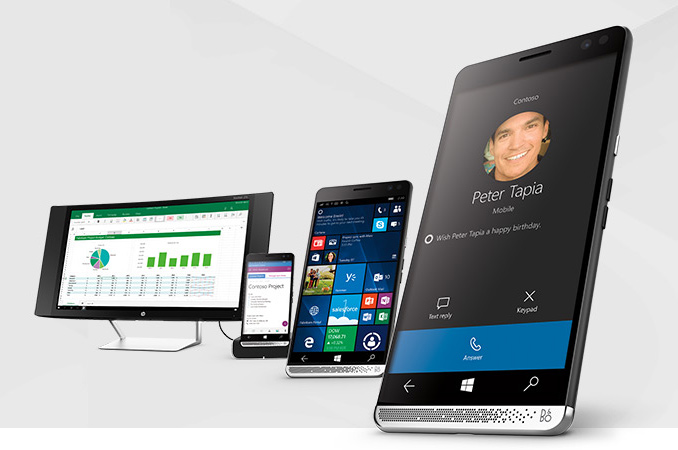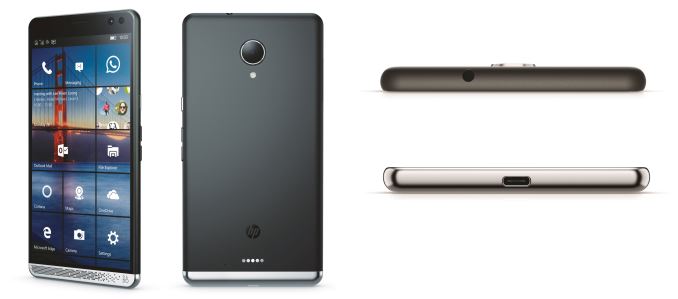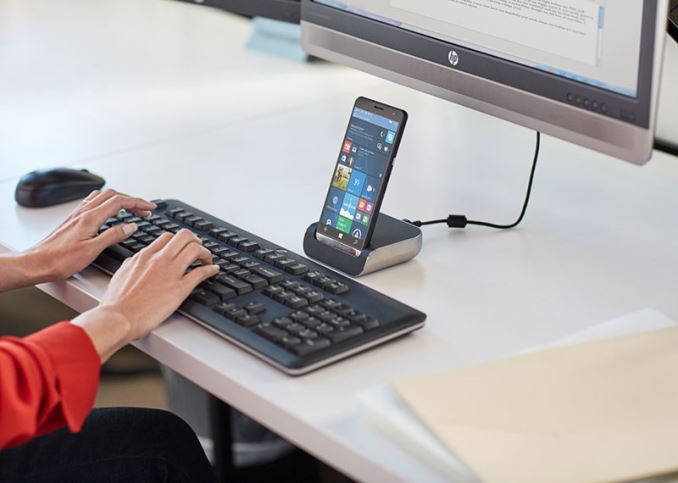HP’s Elite x3 Windows 10 Smartphone to Cost $699, Set to Be Available Worldwide
by Anton Shilov on July 21, 2016 11:00 AM EST- Posted in
- Smartphones
- HP
- Microsoft
- Windows 10 Mobile
- Continuum

When HP introduced its flagship Elite x3 phablet earlier this year at MWC, the smartphone made a very positive impression mostly because HP decided to make a bold move and create a Windows Continuum device aimed purely at the business professional on a company contract. It drew a little ire from some industry analysts, thinking that HP building a Windows phone would never see the light of day. To them it was a paper announcement, but this week shows that the Elite x3 is still alive and well, and coming to consumers and business users. What the company did not announce in February was its recommended price as well as countries, where it planned to make the product available. This weeks details show that the Elite x3 will hit the market in August and will be sold in 46 countries worldwide.
The HP Elite x3 smartphone is based on Qualcomm’s Snapdragon 820 SoC, as well as Microsoft’s Windows 10 Mobile OS. The device is equipped a 5.96” AMOLED display and comes with 64 MB of eMMC 5.1 NAND flash storage, 4 GB of LPDDR4 RAM as well as all the necessary connectivity features, including 4G/LTE, 802.11ac Wi-Fi, Bluetooth 4.0 and a USB Type-C connector. Developed specifically for enterprise and business users, who value security, the device is FIPS 140-2 certified and features Secure Boot (with iris and fingerprint scanners), full disk encryption with a 256-bit key, fTPM 2.0, and so on.
| HP Elite x3 | |
| SoC | Qualcomm Snapdragon 820 2x Kryo @ 2.15 GHz 2x Kryo @ 1.59 GHz Adreno 530 |
| RAM/NAND | 4 GB LPDDR4 RAM, 64 GB eMMC 5.1 NAND microSD 'up to 2 TB' |
| Display | 5.96-inch, 2560x1440 AMOLED (494 PPI) Corning Gorilla Glass 4 |
| Network | X12 Cat 12/13 LTE-A Single Nano-SIM or Dual Nano-SIM Models Micro-SD Shared with Nano-SIM |
| Dimensions | 161.8 x 83.5 x 7.8 (mm) 6.36 x 3.29 x 0.31 (in) |
| Weight | 195 grams 0.43 lb / 6.88 oz |
| Rear Camera | 16 MP, LED Flash |
| Front Camera | 8 MP wide angle, Iris Camera |
| Battery | 4150 mAh, 3.85 V, 15.98 Wh, PMA and Qi charging |
| OS | Windows 10 Mobile |
| Connectivity | Intel AC-7260AN WiFi (2x2 802.11ac + BT 4.0 LE) NFC, GPS USB 3.0 Type-C |
| Additional | Windows Hello (Iris and Fingerprint), FIPS 140-2, fTPM 2.0 128-bit Unified encryption, 256-bit full disk Disaster recovery Protection Win10 includes 128-bit BitLocker and Enterprise Grade VPN Bang&Olufsen Sound 3x Noise-Cancelling Microphones |
| Water/Dust Proof Certification | IP 67 MIL-STD 810G (salt/fog/humidity/shock/thermal) |
While the internal specifications of the HP Elite x3 are impressive, the company does not position the device as just its flagship smartphone. HP believes that there are enterprise customers interested in using one device for multiple workloads and in various situations by taking advantage of Microsoft’s Continuum technology, which allows you to run your phone as a desktop PC. To support such clients, HP intends to offer a special dock (with an Ethernet adapter, DisplayPort USB connectors, etc.) that can work with desktop displays as well as keyboards. When purchased from the HP online store, the dock should come as standard. In addition, the company plans to sell the Mobile Extender laptop, which does not have its own processor or storage, but relies on the Elite x3. The Mobile Extender has a 12.5” display (with 1920x1080 resolution), USB-C ports, speakers as well as a spill-resistant keyboard with a drain and backlighting.
Current competition, at least in the Continuum space, comes from Acer's Liquid Jade Primo which was demoed at MWC and quietly shipped several days ago, and the Lumia 950.
According to Engadget, which cites a representative of HP, the phablet itself will cost $699 in the U.S. and $799 when acquired with a dock, starting from August 29. Slashgear claims that the Elite x3 will cost €863 in the Netherlands and 8,624 SEK in Sweden. Unfortunately, the price of the Mobile Extender is still unknown.
Sources: Engadget, Slashgear, HP Netherlands, HP Sweden.














67 Comments
View All Comments
damianrobertjones - Wednesday, July 27, 2016 - link
I bet you do, you naughty man you!serendip - Thursday, July 21, 2016 - link
So you get no third party apps, enlarged and simplified Office apps when you connect it to a dock, and not much else. For $700 that's a bad joke. Windows Mobile 10 needs an x86 phone that can run legacy Win32 programs as well as UWP apps, a PC in a pocket. This thing is a dead end Windows RT device all over again.Gunbuster - Friday, July 22, 2016 - link
Sadly Intel has nothing to make such a device. Atoms are too slow even in a tablet power envelope and the Core M chips add $300+ to an already high price.extide - Saturday, July 23, 2016 - link
Even a core m isn't the right chip for a device like this. Yeah, the cpu cores on there would be great, and even probably the GPU too (I wonder how competitive Intel is on GPU perf/watt...) but they would probably want to remove all but a few PCIe lanes (wifi, storage, etc) and add in support for stuff common to a phone, like a modem, ufs/emmc support, spi/i2c/etc, etc.. If they made THAT chip, and sold it at a competitive price they could have taken then mobile market, but they just demand too much money for such a solution to make it competitive.smilingcrow - Tuesday, July 26, 2016 - link
The Core M TDP even configuring the TDP down is too high for a phone.Great for a tablet though and some good deals around if you look.
Picked up a Dell Venue 11 Pro direct from Dell with the fastest Broadwell Core M (2.9GHz), 4GB RAM, 128GB SSD, Win8.1/10 Pro for $270 delivered just last week. It can run at 2 to 2.2GHz for an extended period even in a tablet so I wonder how fast they could run in a laptop with more space for cooling?
damianrobertjones - Wednesday, July 27, 2016 - link
There are far too many companies that don't want that to happen.Csfalcao - Monday, July 25, 2016 - link
2nd paragraph ''and comes with 64 MB"